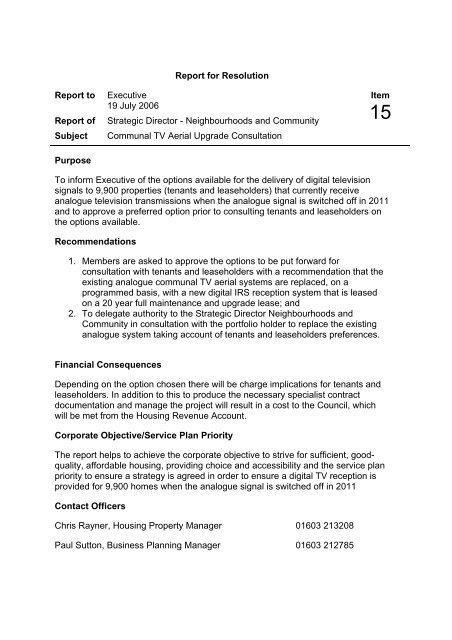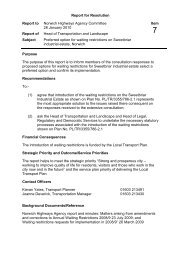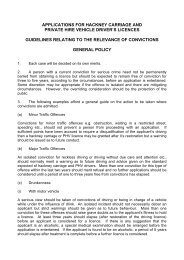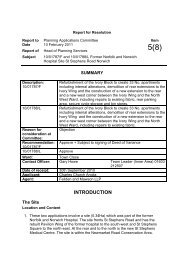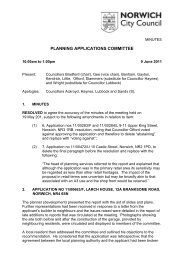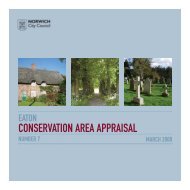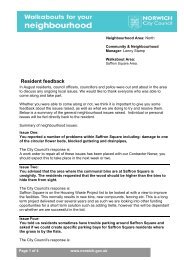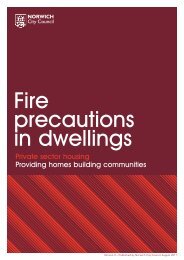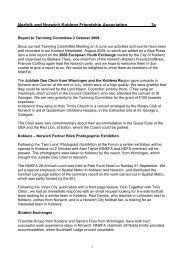Communal Aerial Upgrade Consultation - Norwich City Council
Communal Aerial Upgrade Consultation - Norwich City Council
Communal Aerial Upgrade Consultation - Norwich City Council
You also want an ePaper? Increase the reach of your titles
YUMPU automatically turns print PDFs into web optimized ePapers that Google loves.
Report for Resolution<br />
Report to Executive<br />
19 July 2006<br />
Item<br />
Report of Strategic Director - Neighbourhoods and Community<br />
Subject <strong>Communal</strong> TV <strong>Aerial</strong> <strong>Upgrade</strong> <strong>Consultation</strong><br />
Purpose<br />
15<br />
To inform Executive of the options available for the delivery of digital television<br />
signals to 9,900 properties (tenants and leaseholders) that currently receive<br />
analogue television transmissions when the analogue signal is switched off in 2011<br />
and to approve a preferred option prior to consulting tenants and leaseholders on<br />
the options available.<br />
Recommendations<br />
1. Members are asked to approve the options to be put forward for<br />
consultation with tenants and leaseholders with a recommendation that the<br />
existing analogue communal TV aerial systems are replaced, on a<br />
programmed basis, with a new digital IRS reception system that is leased<br />
on a 20 year full maintenance and upgrade lease; and<br />
2. To delegate authority to the Strategic Director Neighbourhoods and<br />
Community in consultation with the portfolio holder to replace the existing<br />
analogue system taking account of tenants and leaseholders preferences.<br />
Financial Consequences<br />
Depending on the option chosen there will be charge implications for tenants and<br />
leaseholders. In addition to this to produce the necessary specialist contract<br />
documentation and manage the project will result in a cost to the <strong>Council</strong>, which<br />
will be met from the Housing Revenue Account.<br />
Corporate Objective/Service Plan Priority<br />
The report helps to achieve the corporate objective to strive for sufficient, goodquality,<br />
affordable housing, providing choice and accessibility and the service plan<br />
priority to ensure a strategy is agreed in order to ensure a digital TV reception is<br />
provided for 9,900 homes when the analogue signal is switched off in 2011<br />
Contact Officers<br />
Chris Rayner, Housing Property Manager<br />
Paul Sutton, Business Planning Manager<br />
01603 213208<br />
01603 212785
Background Documents<br />
None
Report<br />
Context<br />
1. The <strong>Council</strong> is responsible for providing a communal TV aerial system to 9,900<br />
properties, or 53% of the housing stock, (mainly flats but also a number of<br />
houses) including both tenants and leaseholders. These systems were<br />
designed to carry five television channels (BBC1, BBC2, ITV, Channel 4 and<br />
Channel 5) transmitted in the traditional, analogue format. The distribution<br />
systems are not capable of transmitting digital channels from the terrestrial<br />
(Freeview) and the satellite (Sky and others) broadcasters. This means that<br />
from 2011 when the analogue television signals are switched off in the Anglia<br />
region, in favour of digital transmission, the existing communal television aerials<br />
will cease to deliver a television signal.<br />
2. Due to the popularity of digital television in the UK, over 63% of UK homes now<br />
have digital television of one form or another, this has caused the gradual<br />
proliferation of aerials and satellite dishes attached to houses and flat blocks<br />
within <strong>Norwich</strong> <strong>City</strong>. Permission from <strong>Norwich</strong> <strong>City</strong> <strong>Council</strong> and the Planning<br />
Directorate should be obtained before any aerial or dish is erected, but many<br />
installations are carried out without these permissions.<br />
3. Because most new televisions have integral digital capability and Freeview settop<br />
boxes can be bought for as little as £30, there are an increasing number of<br />
residents and leaseholders requesting the capability of receiving digital<br />
broadcasts, and the level of complaints received by the <strong>Council</strong> is increasing.<br />
4. The implication of digital switchover is that all landlords must decide on a<br />
planned response to the switch-off of analogue broadcasting in the UK. There<br />
is no suggestion from Government that the landlord costs will be met from any<br />
additional funding – although the DCMS have made reference to financial and<br />
practical help for the elderly (over 75) and other vulnerable groups in society –<br />
funded from the BBC license fee. An announcement will be made in due course<br />
on how this support will operate but it is unlikely that social landlords will<br />
qualify.<br />
5. Some 20% of homes in the UK receive television signals though communal<br />
aerials – so it affects flatted housing stock across the whole of the UK. The<br />
DCMS say that 95% of Local Authorities and 74% of RSLs own or manage<br />
properties with communal TV systems. In a survey carried out by the DCMS, in<br />
February 2005, it was found that 37% of LAs and 50% of RSLs have made no<br />
start to the improvement of their aerial systems. This all means that as the<br />
switchover timetable approaches it will become increasingly difficult for<br />
landlords to find aerial contractors with a good track record of installing digital<br />
television distribution systems. There will be an industry skills shortage. Given<br />
this and customer demand there is therefore the need to plan now for the<br />
distribution of digital television signals in our housing stockwell ahead of the<br />
“switch-off”.<br />
6. Appendix A gives the background to the digital television and the platforms<br />
currently available.
System Options<br />
7. Following discussions with several specialist companies including Sky Homes<br />
and Stanley Blick there are two system options available to the <strong>Council</strong>; these<br />
being an Integrated Reception System (IRS) and an upgrading of the existing<br />
system (called a ‘head end’ upgrade). Both systems will deliver a digital signal<br />
but only the IRS system includes all ‘free to air’ channels (replacing the need<br />
for a set top box or integrated television) but tenants and leaseholders will need<br />
to purchase their own satellite receiver in order to receive subscription channels<br />
through the IRS system. This would allow all current resident owned aerials and<br />
satellite dishes to be removed. The ‘head end’ upgrade will only deliver the 5<br />
terrestrial channels and only allow the removal of resident’s own aerials.<br />
8. One other option would be to decommission all equipment and no longer offer<br />
this service. The <strong>Council</strong> has no statutory duty to provide this service. However<br />
this a problematic option because planning restrictions limit each block to one<br />
dish. It is also doubtful if this would be acceptable to residents and for the<br />
purposes of this report this option has not been progressed.<br />
Integrated Reception System (IRS)<br />
9. With an Integrated Reception System, a satellite dish, UHF aerial and radio<br />
antenna are connected by new cables to homes which collects the broadcast<br />
signals from both terrestrial and satellite transmitters, as well as FM and DAB<br />
radio. All available signals are then distributed to a new four-way wall outlet<br />
plate in each flat.<br />
Advantages -<br />
� Provides greater choice for residents because they can choose to only<br />
receive free to view channels or subscribe to any subscription package and<br />
also Sky+ (if this wiring option is adopted).<br />
� Negates the need for individual satellite dishes or aerials, which can be<br />
removed.<br />
� Provides new wiring systems, which we have been advised, are “future<br />
proof”.<br />
� Access to non-English language channels possible thereby giving residents<br />
additional choice and addressing equality and diversity issues.<br />
� As part of the future proofing it is possible to have video door entry systems<br />
linked to the system to allow residents to view who they allow to access the<br />
building, although clearly this would need investment in the necessary video<br />
equipment in communal areas as well as each property, which is currently<br />
not in place.<br />
Disadvantages-<br />
� High installation costs if system purchased not leased ( £175 - £225 per<br />
home)<br />
� More difficult installation and access required to each home.<br />
� More difficult to procure specialist contractors.
� More supervision of works required due to the specialist nature.<br />
Upgrading of Existing System<br />
10. The simplest and cheapest way to upgrade the communal systems to receive<br />
digital broadcasts is to change the aerials and electronics to receive digital<br />
signals, called a “head end” upgrade. NTL have offered to upgrade all of the<br />
existing systems to receive digital broadcasts on a routine basis or as they<br />
need repair within the existing contract. This will mean that some residents may<br />
not be able to receive digital broadcasts until 2010, which is close to the<br />
switchover deadline and would mean an increasing number of enquiries and<br />
complaints, which may be unacceptable. This upgrade involves leaving the old<br />
coaxial cables and old outlet plates in position, which will need<br />
upgrading/replacing at some stage in the future.<br />
Advantages –<br />
� lower costs (about £50 per home) although a contingency budget would be<br />
required for any new wiring found necessary, which is highly likely.<br />
� no access required to individual properties.<br />
� easier and quicker installation process.<br />
Disadvantages –<br />
� Electrical interference on digital channels and re-setting of set top boxes.<br />
� No non-English channels available - fails to recognise diversity.<br />
� Limits choice to “Freeview” only – no access to satellite services.<br />
� Continued proliferation of satellite dishes – disputes & damage.<br />
� Regarded as a temporary solution – rewiring necessary at some point in the<br />
near future.<br />
� Not “future proof”.<br />
Funding Options<br />
Current Costs<br />
11. The current analogue system, owned and maintained by NTL, costs £164,000<br />
per year (Approximately £17 per property per year) this covers hire of<br />
equipment and maintenance. £17,000 of the cost is recovered from<br />
leaseholders connected to the scheme. 436 freeholders are connected to the<br />
system having made a one off payment of £15.00 to be connected for the<br />
duration of the current NTL contract. The remaining £147,000 is pooled across<br />
the Housing Revenue Account (HRA) which means it is funded from the rents<br />
of all tenants regardless of whether they are connected to a communal aerial.
12. In line with the Government policy of rent restructuring it is proposed that any<br />
new contract and costs result in a specific service charge to dwellings which<br />
are connected to a communal system and that the cost is no longer pooled<br />
across all tenants. This charge would be eligible for housing benefit.<br />
Options 1 Integrated Reception System (IRS) Capital Budget Option (outright<br />
purchase)<br />
13. Based on an estimated price of £194 per home outright purchase cost of an<br />
IRS system would be £1,922,500 (note this cost includes contractors<br />
overheads, project management costs etc). An annual maintenance agreement<br />
would cost approx £118,000. The same system but including Sky+ would be<br />
£2,170,000 (again this cost includes contractors overheads, project<br />
management costs etc), with the annual maintenance agreement costing<br />
£138,600. The works could be phased over more than two years, giving an<br />
annual budget of approximately £1 million per annum depending on which<br />
option is adopted. This would have to be found from the existing Housing<br />
Investment Capital budget, at the expense of an existing programme, as no<br />
further funds are available.<br />
14. Tenants would not be liable for installation costs but would face a specific<br />
weekly service charge for maintenance of between £0.23 and £0.27 depending<br />
on the option chosen. Leaseholders and freeholders would be liable for the one<br />
off installation cost and an annual maintenance fee.<br />
Option 2 Head End <strong>Upgrade</strong><br />
15. Head End upgrades are cheaper and at £50 per home would cost £495,000, or<br />
close to £250,000 per year over two years. This is a more affordable option. A<br />
contingency budget of £50,000 a year would also be required for any additional<br />
wiring upgrades.<br />
16. The option offered by NTL to upgrade the head end on a rolling programme<br />
would cost nothing, but would take up to 5 years to complete as upgrades will<br />
only take place as systems fail. There would be an undoubted increase in<br />
charges for tenants and leaseholders with ntl currently pressing for an annual<br />
increase of almost 30% on current charges.
17. Table 1 - Outright purchase potential charges<br />
Option Total cost Cost per<br />
dwelling<br />
Maintenance<br />
Annual<br />
Cost per<br />
home<br />
Sky £1,922,500 £194 £12 £0.23<br />
Sky + £2,170,000 £220 £14 £0.27<br />
Head end<br />
upgrade<br />
ntl upgrade Estimated<br />
£211,560<br />
£ 495,000 £50 0 0<br />
Option 3 Leasing an Integrated Reception System.<br />
£21.00 £0.41<br />
Maintenance<br />
Weekly cost<br />
per home<br />
18. The alternative to using capital to procure the works is through a lease<br />
agreement where the cost of the upgrade work is paid for by the service<br />
provider who then leases the service back to the <strong>Council</strong>. With most major<br />
installers strategic partnerships can be entered into over a period of 10 years or<br />
longer. In this way the capital cost is met by the service provider and the IRS<br />
service is leased.<br />
19. The costs and charges of leasing are illustrated below. This charge would be<br />
recovered from leaseholders in their service charge and set up as a weekly<br />
service charge for tenants. As previously noted this weekly service charge<br />
would be covered by housing benefit, which will mean that in adopting this<br />
option we will not be increasing the financial burden on those tenants on<br />
benefit. Companies are reluctant to offer a lease option for a head end<br />
upgrade that also includes maintenance of the existing wiring and fittings.<br />
20. Table 2-Leasing option potential charges<br />
Option Total cost Annual<br />
Cost per<br />
home<br />
Weekly<br />
Cost per<br />
home<br />
Sky 10 years £460,000 £47.00 £0.90<br />
Sky 20 years £305,000 £31.00 £0.60<br />
Sky + 10 years £520,800 £53.00 £1.00<br />
Sky +20 years £347,200 £35.00 £0.68<br />
21. Another financial consideration is whatever system is adopted, unless an<br />
extension of the existing contract is negotiated, the <strong>Council</strong> will have to buy the<br />
existing system back from NTL. A price has not been given, but is unlikely to<br />
exceed £20,000.
Contract Procurement<br />
22. Due to the nature of this work specialist skills and knowledge are required for<br />
the procurement process and it will be necessary to appoint a consultant to<br />
prepare the tender documentation. The availability of such specialists is limited<br />
(particularly in view of the short timescale to the switchover date and the<br />
volume of work to be carried out nationally) and consideration is being given,<br />
and legal advice is being sought, to determine the most efficient approach to<br />
appointing such a specialist.<br />
23. Project management of the programme is another specialist area however the<br />
costs for this work are included in the funding options and are approximately<br />
£100,000 over the term of the contract.<br />
Timescales<br />
24. The intention is to use the remainder of this financial year to procure the<br />
contract in order that we have a contractor ready to start on site after April<br />
2007. The detailed programme of work would need to be agreed with the<br />
successful contractor but in terms of the overall high level programme<br />
anticipated timescales for each option are:<br />
� Full IRS system either outright capital purchase or leased option is two to<br />
three years.<br />
� Head end upgrade of existing system is two years.<br />
� NTL head end upgrade would be carried out over the next five years but<br />
exact timescales would be entirely dependant on the reliability of each<br />
system over that period (as upgrading would only take place if systems<br />
failed or required considerable maintenance) and would not allow us to<br />
notify residents of the intended programme of upgrade work in advance.<br />
Other Considerations<br />
25. As mentioned previously there are a limited number of approved contractors<br />
able to carry out this specialist work and with the switchover date rapidly<br />
approaching their services will be in demand and prices will rise, so we need to<br />
ensure we use the remainder of this year to procure the work in order to make<br />
a start on site next year.<br />
<strong>Consultation</strong><br />
26. It is proposed that all tenants and leaseholders, in affected dwellings, be<br />
informed that the current analogue communal TV aerial systems system needs<br />
to be replaced and the <strong>Council</strong>s preferred option is a new digital IRS reception<br />
system as this will give tenants and leaseholders access to more channels and<br />
reduce future costs. It is intended to recommend that it is leased on a 20 year<br />
full maintenance and upgrade lease. The consultation document will explain<br />
fully why the change is necessary and what the potential costs are. The<br />
consultation will invite comments from tenants and leaseholders and an
indication on which option they would prefer. The Authority will need to<br />
demonstrate to all tenants and leaseholders that the proposed solution is value<br />
for money and that any cost will be reasonably incurred. Because the cost to<br />
individual leaseholders will be less that £100 per year a full section 20<br />
consultation will not be required.<br />
Conclusion<br />
27. Whilst the upgrade of the existing system by NTL is the cheapest option it is not<br />
considered best value for money as further upgrade work of cabling etc will be<br />
required in the near future and this system will not be ‘future proof’ in terms of<br />
technological improvements and changes. By far the best value for money<br />
solution in the long term will be the IRS system, and this is the system that the<br />
vast majority of other social landlords are adopting, but the ‘up-front’ capital<br />
cost of such a system effectively makes it unaffordable for the <strong>Council</strong> given the<br />
need to spend capital resources on meeting Decent Homes targets and other<br />
tenant aspirations. However, the same system can be leased with a full<br />
maintenance system at a cost comparable to the existing analogue system with<br />
the added benefit of providing residents with a choice of digital services,<br />
helping address the e-government agenda and equality and diversity issues<br />
that may exist. A further consideration is the level of choice provided to<br />
residents and whether, for the marginal additional cost (£5 per property per<br />
year or 9 pence per property per week), we provide a system that allows the<br />
resident to choose Sky+. An additional benefit is that future budget setting and<br />
provision is known and so gives added certainty to future costs.
APPENDIX A<br />
Background to digital television<br />
1. Digital television was launched on 1 October 1998 and has enabled<br />
broadcasters to vastly increase the choice of programmes available to viewers<br />
from the Terrestrial (through an aerial), Satellite (through a dish), Cable (though<br />
underground cables) or Broadband (through DSL telephone lines) suppliers.<br />
For the Terrestrial and Satellite suppliers this expanding choice includes new,<br />
free-to-view and subscription services – far beyond the familiar BBC, ITV,<br />
Channel 4 / S4C and Five terrestrial services. Services from Cable and<br />
Broadband all require subscription payments. Interactive services within digital<br />
broadcasting are also growing; playing an increasingly important role in the egovernment<br />
agenda.<br />
2. The Secretary of State confirmed in September 2005 the switchover to digital<br />
broadcasts will be between 2008 and 2012 ensuring universal access to highquality,<br />
free-to-view and subscription digital TV. For the Anglia region, the<br />
switchover will take place in 2011. In order to receive digital television services<br />
from one of the suppliers viewers must be equipped with a digital receiver,<br />
commonly known as a “set top” box. These are available from the High Street<br />
retailers. Alternatively, you can purchase a digital-ready television from the<br />
High Street, these are known as Integrated Digital Television sets (iDTV) and<br />
have the digital receiver integrated into the television itself. In all cases, ofcourse,<br />
the digital receiver must be able to receive the required digital signals.<br />
In blocks of flats this means either having your own aerial or dish or being able<br />
to plug the box into a communal aerial that delivers all of the required digital<br />
signals.<br />
Available Television Platforms<br />
3. There are three different types (or “platforms”) of digital television available in<br />
<strong>Norwich</strong> to choose from: satellite (Sky), terrestrial (freeview) or cable. With<br />
terrestrial residents can buy a set top box (currently £35 to £150 depending on<br />
quality), which connects between the television set and the aerial source.<br />
Connection is usually undertaken by the householder themselves. The<br />
Freeview box delivers 30 television channels and a growing number of digital<br />
radio stations. There is no monthly subscription for Freeview – although there is<br />
“Top-Up TV” which tops up the service with eleven subscription channels.<br />
With satellite residents can access free-to-view channels and a range of<br />
subscription channels. The “Freesat” service from Sky offers 120 digital TV<br />
channels and 80 digital radio channels. Alternatively, residents can subscribe to<br />
Sky and build their own digital television package, from six channel mixes, up to<br />
500+ channels. Residents can opt for the Sky+ service, which includes a<br />
personal video recorder recording directly to the Sky+ box at the touch of a<br />
button ,no tapes and no timers as well as pausing live tv action and returning<br />
later and instantly rewinding.<br />
Another satellite free-to-view service is being planned for launch early in 2006.<br />
The BBC and ITV are currently exploring a new satellite service, which will<br />
provide free-to-view services delivered from the Astra satellite.
Cable (NTL / TeleWest) provides up to 160 channels on subscription packages. It<br />
does not currently offer free channels but plans are being made to do so. Cable<br />
access is not currently provided to all <strong>Council</strong> housing in <strong>Norwich</strong>.


